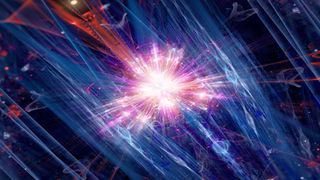Fission involves splitting atoms; fusion is about combining them.
By Adam Mann - Live Science Contributor 4 days ago

Computer generated artistic impression of fission. (Image credit: Getty Images)
Fission and fusion are both natural atomic processes that release incredible amounts of energy, but in many ways, they are opposites. Fission involves the splitting of a single, generally heavy, atomic nucleus, whereas fusion requires the combining of two or more light atoms.
Atoms include protons and neutrons bound together in a central nucleus. Radioactive elements, like uranium, may contain dozens of these particles in their atomic hearts.
Fission occurs when heavy elements such as uranium spontaneously decay, which causes their nuclei to split. Each of the resulting halves has slightly less mass than the original atomic core, and the missing mass is converted to energy.
Physicists Lise Meitner and Otto Frisch discovered the principles underlying fission after receiving a private letter from nuclear chemist Otto Hahn in December 1938. Hahn's experiments showed that uranium atoms that were bombarded with neutrons would split, and Meitner and Frisch used the new science of quantum mechanics to explain why this happened.
All three scientists soon realized the terrible implications of their discovery, which was happening under the shadow of World War II. A single instance of fission might release a relatively small amount of power, but many fission reactions happening at the same time had the potential to be quite destructive if used to develop something like an atomic bomb.
NUCLEAR FISSION FOR ENERGY AND WEAPONS
When a uranium atom naturally goes through fission, it releases a neutron that will careen around. If this neutron hits other nearby uranium atoms, they will also split, creating a cascading chain reaction. In 1951, engineers built the first power plant harnessing the process of nuclear fission to produce energy, according to the U.S. Department of Energy.
In a nuclear power plant, this process is carefully controlled. Fission releases heat, which boils water and generates steam that spins a turbine.
But in an atomic bomb, the cascading chain reaction spirals out of control, with fission happening at an ever-increasing rate. This releases a tremendous amount of power in a short span, generating the devastating blast of the bomb.
WHY FUSION DOESN'T PRODUCE ENERGY, YET
The International Thermonuclear Experimental Reactor's plasma core is halfway done. This is the tokamak complex, which will house plasma that is 10 times hotter than the sun, once it is complete. (Image credit: ITER)
Fusion, by contrast, has yet to be fully developed as a human power source. In nuclear fusion, two nuclei of a light element, such as hydrogen, must overcome their natural electromagnetic repulsion and merge into a single, heavier nucleus.
The resulting entity is slightly less massive than the original two nuclei, and just like with fission, this missing mass is converted into energy. But generating enough power to smash atoms together until they stick is not easy and generally requires the extreme environment of a star's belly to happen.
Engineers have long dreamed of making sustained fusion reactions here on Earth. Fusion power would produce less nuclear waste than fission and uses relatively common light elements, such as hydrogen — rather than rarer uranium — as a fuel supply, according to the International Atomic Energy Agency.
But creating and sustaining fusion is difficult. An international experiment to test the feasibility of using sustained nuclear fusion to produce energy has built a magnet that's as tall as a four-story building and 280,000 times more powerful than Earth's magnetic field, as part of the International Thermonuclear Experimental Reactor (ITER).
But ITER, a scientific partnership among 35 countries, has suffered numerous delays during its construction and isn't expected to generate more power than it consumes until at least the 2030s.
The International Thermonuclear Experimental Reactor's plasma core is halfway done. This is the tokamak complex, which will house plasma that is 10 times hotter than the sun, once it is complete. (Image credit: ITER)
Fusion, by contrast, has yet to be fully developed as a human power source. In nuclear fusion, two nuclei of a light element, such as hydrogen, must overcome their natural electromagnetic repulsion and merge into a single, heavier nucleus.
The resulting entity is slightly less massive than the original two nuclei, and just like with fission, this missing mass is converted into energy. But generating enough power to smash atoms together until they stick is not easy and generally requires the extreme environment of a star's belly to happen.
Engineers have long dreamed of making sustained fusion reactions here on Earth. Fusion power would produce less nuclear waste than fission and uses relatively common light elements, such as hydrogen — rather than rarer uranium — as a fuel supply, according to the International Atomic Energy Agency.
But ITER, a scientific partnership among 35 countries, has suffered numerous delays during its construction and isn't expected to generate more power than it consumes until at least the 2030s.
ADDITIONAL RESOURCES
Check out this helpful table that lists the difference between fission and fusion, from Chemistry LibreTexts.
Watch this video from the U.S. Department of Energy summarizing how fission and fusion work.
Learn more about the ITER experiment on the project's website.
JUMP TO:
Adam Mann is a journalist specializing in astronomy and physics stories. He has a bachelor's degree in astrophysics from UC Berkeley. His work has appeared in the New Yorker, New York Times, National Geographic, Wall Street Journal, Wired, Nature, Science, and many other places. He lives in Oakland, California, where he enjoys riding his bike. Follow him on Twitter @adamspacemann.
No comments:
Post a Comment